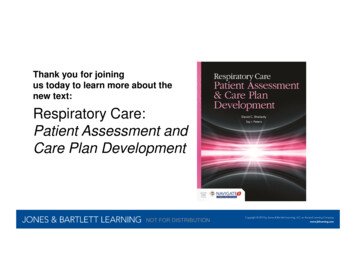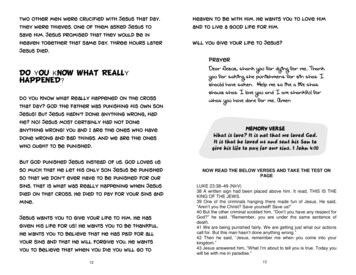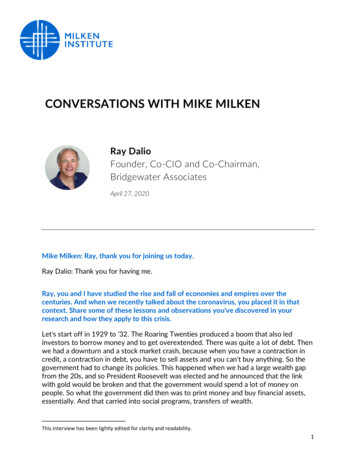
Transcription
Thank you for joiningus today to learn more about thenew text:Respiratory Care:Patient Assessment andCare Plan DevelopmentNOT FOR DISTRIBUTION
Respiratory Care: Patient Assessment andCare Plan Development Published: 12/1/14ISBN-13: 9781449672447List Price: 99.95Pages: 716HardcoverTrim: 8 1/2 x 10 7/8, full-colorFirst EditionNOT FOR DISTRIBUTION
AuthorsDavid C. Shelledy, PhD, RRT, RPFT, FAARC, FASAHP,Professor and Dean, School of Health Professions, University ofTexas Health Science Center, San Antonio, TexasDean Emeritus and Professor, Departments of Respiratory Care,Clinical Sciences, and Health Systems Management, RushUniversity, Rush University Medical Center, Chicago, IllinoisJay I. Peters, MD, Professor and Chief, Division of Pulmonaryand Critical Care Medicine, School of Medicine, University ofTexas Health Science Center, San Antonio, TexasNOT FOR DISTRIBUTION
Instructors Praise This Approach"This text provides foundational information needed to develop Respiratory Therapists that are able to function as critical thinkers.A new student should be able to read the information provided here and participate in thorough patient information gathering. Thetext utilizes case studies at varying points throughout the reading to help the student determine if they are understanding and ableto pick out key identifiers related to patient assessment. The stepwise approach is pertinent to today's respiratory therapistworkforce."--Rebecca A. Higdon, MS, RRT, Director of Clinical Education, Elizabethtown Community & Technical College"[Respiratory Care: Patient Assessment and Care Plan Development] is well organized and the use of research and literaturereview within the text is a good method of introducing its use while also covering content. The various areas to consider in careplanning were detailed very well while also including diagnostics and pathology which are crucial for critical thinking andassessment.I love the additional materials on research and the case studies. The use of literature review results, tables of informationthroughout, and case studies were well developed. Very well done." M. Marcia Fuller, MAE, RRT, Professor and Program Director of Respiratory Care, Bowling Green Technical College"Much more in-depth than any other books I have read on Care Plan development."--Cynthia McKinley BAAS, RRT, Assistant Professor, Director of Clinical Education, Lamar Institute of TechnologyNOT FOR DISTRIBUTION
Overview A comprehensive guide to the evaluation of the patient, and thedevelopment and implementation of an appropriate, evidence-based,respiratory care planDescribes the purpose of patient assessment and then guides the readerthrough the process of the reviewing existing data in the medical record,conducting the patient interview, performing the physical assessment,evaluating the diagnostic studies needed and then developing andimplementing a respiratory care planBridging the gap between patient assessment and treatment, the reader willlearn how to apply assessment skills to the development andimplementation of evidence-based respiratory care plansCritical diagnostic thinking is reviewed and then applied to specific patientsituationsNOT FOR DISTRIBUTION
Pedagogical Elements Chapter ObjectivesChapter OutlinesKey TermsHundreds of full-colorIllustrations, Photos &Tables Boxed Articles and Notes Clinical PracticeGuidelinesNOT FOR DISTRIBUTION
RC InsightsNOT FOR DISTRIBUTION
Clinical FocusNOT FOR DISTRIBUTION
Chapter Summary and Key PointsNOT FOR DISTRIBUTION
Goals This book was created to provide students and clinicians concernedwith the assessment and care patients with cardiopulmonary disordersa comprehensive guide to patient assessment with an emphasis on:–– Patient evaluationImplementation of appropriate, evidence–based respiratory care plansThe focus is on the assessment, diagnostic evaluation, treatment, andcare of patientsThe primary audience is the respiratory therapist with the goal ofproviding the knowledge and skills needed for advanced practiceWe believe the information contained will be of great value to thosewho prescribe respiratory care and for all healthcare practitionersinterested in optimizing outcomes for patients with heart and lungdiseaseContent needed to pass the NBRC exams is includedNOT FOR DISTRIBUTION
Table of hapterChapterChapter1 Introduction to Patient Assessment2 Development and Implementation of Respiratory Care Plans3 Review of the Medical Record4 Patient History5 Physical Assessment6 Assessment of Oxygenation7 Assessment of Ventilation8 Blood Gas Analysis, Hemoximetry, and Acid-Base Balance9 Laboratory Studies10 Cardiac Assessment and the Electrocardiogram11 Cardiopulmonary Imaging12 Adult Pulmonary Function13 Bronchoscopy and Special Procedures14 Acute and Critical Care Monitoring and Assessment15 Obstructive Sleep Apnea16 Neonatal and Pediatric AssessmentNOT FOR DISTRIBUTION
Content The book has a natural flow:–It begins by describing the purpose of patient assessment (Chapter 1) andmethods associated with evidence-based practice. Introduction to patient assessmentWhy it is so importantFactors that affect healthDrivers of the health care system (cost, access and quality and the triple aim of health carereform)Evidence-based practiceSources and types of evidenceQuestions for evidence-based practice (how to do it)Recommendations for therapy– Critical diagnostic thinking is then reviewed Steps to establish a diagnosisCommon (and less common) assessment findingsTypical presentations of common respiratory disordersNOT FOR DISTRIBUTION
NOT FOR DISTRIBUTION
NOT FOR DISTRIBUTION
NOT FOR DISTRIBUTION
NOT FOR DISTRIBUTION
NOT FOR DISTRIBUTION
NOT FOR DISTRIBUTION
Critical Diagnostic ThinkingNOT FOR DISTRIBUTION
Content The book has a natural flow:– Critical diagnostic thinking is then applied to the development andimplementation of evidence-based respiratory care plans (Chapter 2). Introduction to care plansRespiratory care plan developmentSpecific care plans– Maintain adequate tissue oxygenation– Treat and/or prevent bronchospasm»» Respiratory care plans for asthmaRespiratory care plans for COPD– Mobilize and remove secretions– Provide lung expansion therapy– Critical care and mechanical ventilation– Diagnostic testingRespiratory care plan formatNOT FOR DISTRIBUTION
NOT FOR DISTRIBUTION
ReviewsIndications for therapies and diagnostic testingTreatment of common problems Respiratory failure Oxygenation problems Ventilatory failure Bronchospasm and mucosal edema Asthma and COPD (includes medications –acute and chronic) Secretion management Lung expansion therapy Critical care and mechanical ventilationNOT FOR DISTRIBUTION
Content The book has a natural flow:– The book then guides the reader through the– Review of existing data in the medical record (Chapter 3) Patient interview (Chapter 4) Physical assessment of the patient (Chapter 5) Ordering and evaluation of the diagnostic studies neededChapters 6 through 8 focus on the assessment of –Oxygenation, ventilation, and arterial blood gas sampling and interpretation (includesoximetry)Chapter 9 reviews laboratory studies Hematology, clinical chemistry, microbiology Assessment of sputum, urinalysis, skin testing Histology and cytology, and molecular diagnosticsNOT FOR DISTRIBUTION
Assessment ResourcesNOT FOR DISTRIBUTION
Chapters 4 and 5 Tables, Boxes and Figures Interview questions for coughDescription of cough and sputum productionCommon causes of dyspneaDyspnea rating scales (e.g. Borg, SOBQ, MMRC,VAS)Items to include in the patient historyGeneral history and history of chest illnessquestionnairesMedical history for asthma patientsSmoking and tobacco use interview questionsEffective smoking cessation techniques (5 As and5Rs)Occupational lung diseaseChecklist for physical assessment for care plandevelopmentSteps in physical examinationVital signsTreatment of hypertension FeverPain recognitionBMI, obesity and health risksMental status and neurologic exam(Glasgow, Ramsey sedation scale,Richmond agitation scale, Mini-MentalState Exam)Chest inspection summaryPalpation techniquesPercussion findingsClinical implications of breath soundsChest painHeart soundsSkin appearance and edema gradesPhysical findings of common respiratorydiseaseNOT FOR DISTRIBUTION
ImagesNOT FOR DISTRIBUTION
ImagesNOT FOR DISTRIBUTION
Content The book has a natural flow:–––––––In Chapter 10, ECG monitoring and interpretation are discussed to include findings withspecific cardiac disordersChapter 11 focuses on imaging techniques to include the chest radiograph, CT scan, MRI,and other imaging studies used in the evaluation of the respiratory care patient andincludes the evaluation of imaging findings associated with specific pulmonary diseasesPulmonary function testing is described in Chapter 12 to include the evaluation of patientswith obstructive and restrictive diseaseChapter 13 details diagnostic bronchoscopy and other diagnostic studies.Acute and critical care monitoring with a focus on the patient receiving mechanicalventilatory support is covered in Chapter 14Chapter 15 addresses the use of sleep studies in the evaluation of the cardiopulmonarypatientLast, but not least, Chapter 16 covers maternal and perinatal/neonatal patientassessmentNOT FOR DISTRIBUTION
ImagesNOT FOR DISTRIBUTION
ImagesNOT FOR DISTRIBUTION
ImagesNOT FOR DISTRIBUTION
Instructor Resources Lecture Outlines in PowerPoint FormatTest BankSample SyllabusImage BankNOT FOR DISTRIBUTION
Instructor and Student ResourcesHelpful Forms and Checklists available as printable PDFs Use of Questions in Evidence-Based PracticeSOAP Format for Organizing a Respiratory Care PlanDetailed Respiratory Care Plan FormatMechanical Ventilation Flow SheetRespiratory Care Assessment Medical Record Review Data Collection FormForm for General Past Medical HistoryPatient Interview Questions Related to the CoughPatient Interview Questions Related to Phlegm, Sputum, or Mucus ProductionPatient Interview Questions Related to HemoptysisHistory of Chest IllnessSmoking and Tobacco Use Interview QuestionsChecklist for the Physical Assessment for Respiratory Care Plan DevelopmentMini-Mental State ExaminationAssessment of OxygenationNOT FOR DISTRIBUTION
Student ResourcesWhether you teach an online, hybrid, or traditionalclassroom-based course, Navigate 2 deliversunbeatable value. Navigate 2 provides access tomobile-ready course materials:Learn: A complete eBook with interactive toolsPractice: A virtual Study Center with robust practiceactivities and flashcardsAssess: A homework and testing Assessmentcenter with prepopulated quizzes and examinationsNavigate Advantage AccessDigital Only 49.95*ISBN-13: 978-1-4496-7207-2Available Mid March 2015Analyze: A dashboard that reports actionable data* List Price. Price subject to change.NOT FOR DISTRIBUTION
Navigate 2 Advantage Access eBook– Knowledge Checks– End-of-Chapter Graded Quizzes– AnimationsStudy Tools– Learning Objectives– Flashcards– Practice Activities– Chapter Overview PresentationSlides in PowerPoint format Assessments– Lesson Quizzes– Midterm– FinalNOT FOR DISTRIBUTION
Navigate 2HomepageNOT FOR DISTRIBUTION
eBook Sample ViewNOT FOR DISTRIBUTION
Study CenterNOT FOR DISTRIBUTION
Knowledge Check Questions within eBookNOT FOR DISTRIBUTION
FlashcardsNOT FOR DISTRIBUTION
Grade BookNOT FOR DISTRIBUTION
Recap of Features Content needed to pass the National Board for Respiratory Care entry level and advanced respiratory careexaminations is included throughoutFollows AARC Clinical Practice GuidelinesCritical diagnostic thinking is reviewed and then applied to specific patient situationsChapter Objectives, Chapter Outlines, Key Terms, hundreds of full-color illustrations, photos & tables, BoxedArticles, Notes, and Clinical Practice Guidelines are incorporated into each chapter for enhanced student learningBoxed Chapter Features: Clinical Focus: Exercises designed to help refine critical thinking and problem-solving skills serve as mini-casestudies which pose questions to readers so they can apply essential concepts to real-world scenarios RC Insights!: Interspersed throughout the text, these tips provide the clinician with useful information on patientassessment and management Key Points: Listed at the conclusion of each chapter, these recaps summarize important facts and conceptsInstructor Resources: Lecture Outlines in PowerPoint Format, Test Bank, Sample Syllabus, and Image BankStudent Resources: Each new print copy includes Navigate 2 Advantage Access that unlocks a complete eBook,Study Center, homework and Assessment Center, and a dashboard that reports actionable data.NOT FOR DISTRIBUTION
Thank you for joining ustoday to learn more aboutRespiratory Care:Patient Assessment andCare Plan DevelopmentWe hope you will enjoy adding thisfabulous resource to your Respiratory Carecurriculum.NOT FOR DISTRIBUTION
Contact UsFor more information, visit: http://go.jblearning.com/Shelledy Request a review copy Request instructor resourcesContact your Health Professions Account Specialistvia email: http://go.jblearning.com/findarepOr call 1-800-832-0034Browse our website for additional resources: www.jblearning.comNOT FOR DISTRIBUTION
Dec 01, 2014 · respiratory care plan Describes the purpose of patient assessment and then guides the reader through the process of the reviewing existing data in the medical record, conducting the patient interview, performing the physical assessment, evaluating the diagnostic studies needed and then developing











